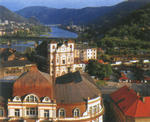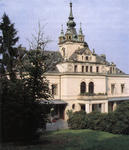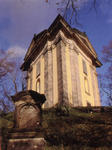
The district town of Usti nad Labem, which today has more than 97,000 people, was founded at the confluence of the Labe (Elbe) and Bilina Rivers. The valley in which the city is situated is sheltered by two steep cliffs - Marianska on the north and Strekov on the southeast - and two hills.
The valley has been traversed by major trade routes since the beginning of time. In addition to the
"Serbian" route, the
"Salt Path" (which once supplied Bohemia with its salt) used to lead through Usti to Saxony. Furthermore, the town was and still is a port on the Labe River and had a customs office beginning in the 10
th century. A prince's fort was also once located on the site of the contemporary city and was used to protect river navigation. Later, a market village was established underneath the fort and in the 13
th century, King Premysl Otakar II granted Usti official city status. It later gained royal city status, which brought with it doubled walls, a moat, and the "Old Usti Castle." The privileges of the city were extended by King John of Luxemburg, who granted it the rights of free navigation and mileage (the latter gave the town authority over all trade within a mile of the center).
The prosperous town was badly destroyed by a fire in 1538 that consumed a great number of important buildings

including the church, town hall, and mill. Local burghers built a new Renaissance town hall - complete with beautiful interiors and cellars - on the north side of the square. Superb "podskalske" (under the cliff) wine was once stored in the spacious cellars. During the Thirty Years' War, the city was plundered badly and armies left the city almost completely in ruins. In the 18
th century, the Dominican Order succeeded in rebuilding the Gothic Church of St. Vojtech and constructed a
Baroque monastery nearby, both of which were based on the plans of the architect Octavio Broggio. Usti preserved its medieval town characteristics until the 19
th century, when the advent of the railway and heightened use of water transport created conditions for intensive coal mining. Subsequently, everything in the path of rapid industrial development was destroyed without feeling. The city gates and walls were torn down, the moat was filled in, and the historical center was damaged both by reconstruction and bombing during World War II. Today only a small section of the big industrial city has managed to retain the character of the historic royal city.
Of the historical monuments in Usti, special attention should be paid to
the Church of Ascension of the Virgin Mary. This medieval town church is probably of early Feudal origin, even though it was only mentioned for the first time in 1249. The Baroque Church of St. Vojtech has been reconstructed several times and today serves as an exhibition and concert hall. Tourists should also visit the nearby Strekov Castle, which was built by John of Luxemburg about 1319 in order to protect river navigation. Likewise, it is also possible to visit the nearby castle of Krasne Brezno, which was built circa 1603.



 Guide
Guide 





